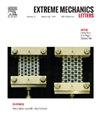Effect of rate on the response and localized transformation patterns in NiTi Tubes
IF 4.3
3区 工程技术
Q2 MATERIALS SCIENCE, MULTIDISCIPLINARY
引用次数: 0
Abstract
Tensile tests on NiTi tubes at different average strain rates reveal a unique behavior resulting from interactions between the latent heat of the reversible transformations, the transformation stress and the associated localized deformation patterns. At slow rates (e.g., 10−5 s−1) transformation is by a helical band or multipronged fronts. The heat exchange with the environment dissipates the latent heat, the temperature remains at the ambient level, and the stress remains constant during transformation. At a rate of 10−2 s−1 three narrow parallel helical bands of martensite (M) nucleate simultaneously at one end. Their tips propagate at the same speed, while the stress remains constant at the level corresponding to the temperature of the transformed material behind them. Once they reach the other end, further transformation occurs by band broadening accompanied by heating and increase in the recorded stress. During unloading, three helical bands of austenite (A) covering the length of the specimen nucleate nearly simultaneously and subsequently broaden causing cooling and decrease in stress. This behavior is contrasted with that observed in strips and small diameter rods where during loading rate-induced heating results in progressive nucleation of new inclined bands of M at sites with lower temperature. The progressive nucleation of new inclined bands (of A) is repeated during unloading. The rate tube experiments have been successfully simulated numerically using coupled static displacement-transient thermal finite element analysis linked to a user material subroutine based on the thermomechanical constitutive model for SMAs of our group. The following novel features of the analysis are crucial for successful simulations: both transformations are represented by a single surface with softening introduced over their extents; the transformation stress, strain and latent heat vary with temperature; the heat exchange between the model and the environment is modeled appropriately. Overall, the results of the experiments provide a challenging platform for developing and evaluating constitutive models for phase transforming materials, while the analysis points to features that must be included.
速率对镍钛管响应和局部转化模式的影响
在不同平均应变速率下对镍钛管进行的拉伸试验揭示了可逆转变潜热、转变应力和相关局部变形模式之间相互作用所产生的独特行为。在低应变速率下(例如 10-5 s-1),转变是通过螺旋带或多棱形前沿进行的。在转化过程中,与环境的热交换会耗散潜热,温度保持在环境温度水平,应力保持恒定。马氏体(M)以 10-2 s-1 的速度在一端同时形成三条狭窄的平行螺旋带。它们的尖端以相同的速度传播,而应力则保持恒定,与它们后面的转化材料的温度相对应。当它们到达另一端时,伴随着加热和记录应力的增加,通过带状扩展发生进一步转变。在卸载过程中,覆盖试样长度的三条奥氏体螺旋带(A)几乎同时成核,随后变宽,导致冷却和应力下降。这种行为与在带材和小直径棒材中观察到的行为形成鲜明对比,在带材和小直径棒材中,加载过程中速率引起的加热导致在温度较低的部位逐渐形成新的 M 倾斜带。在卸载过程中,新倾斜带(A)的逐渐成核过程会重复出现。我们使用静态位移-瞬态热耦合有限元分析法对速率管实验进行了成功的数值模拟,该分析法与基于我们课题组 SMA 热力学构成模型的用户材料子程序相连接。分析中的以下新特点对成功模拟至关重要:两种转变均由单一表面表示,并在其范围内引入软化;转变应力、应变和潜热随温度变化而变化;模型与环境之间的热交换被适当建模。总之,实验结果为开发和评估相变材料的构成模型提供了一个具有挑战性的平台,同时分析指出了必须包含的特征。
本文章由计算机程序翻译,如有差异,请以英文原文为准。
求助全文
约1分钟内获得全文
求助全文
来源期刊

Extreme Mechanics Letters
Engineering-Mechanics of Materials
CiteScore
9.20
自引率
4.30%
发文量
179
审稿时长
45 days
期刊介绍:
Extreme Mechanics Letters (EML) enables rapid communication of research that highlights the role of mechanics in multi-disciplinary areas across materials science, physics, chemistry, biology, medicine and engineering. Emphasis is on the impact, depth and originality of new concepts, methods and observations at the forefront of applied sciences.
 求助内容:
求助内容: 应助结果提醒方式:
应助结果提醒方式:


